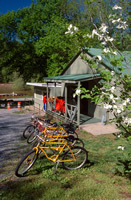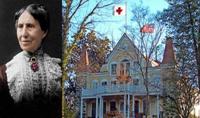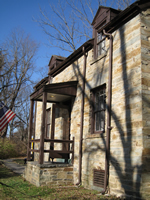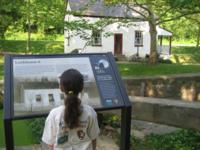The Powerful Potomac
By Ranger Kelly
Lockhouses:
Floods:
Lockkeepers:
I learned in school about George Washington's love for the Potomac River and how it influenced many of his decisions. However, I did not fully understand that passion until I moved here in 2009 and became a park ranger on the C&O Canal. Shortly after arriving, we had a minor flood event. As I watched huge logs and other debris floating down the river, the water's power captivated me. The speed at which the water rose demanded my respect. As the seasons passed and the water level dropped, I also found tranquility along its banks and beauty in the geological formations carved out by the river. These cycles of high and low water scour and deposit soils, transporting seeds into the most unlikely places, creating one of the most biologically diverse areas in the country. No other major river in the Eastern U.S. is as wild as this one. I am in awe of the mighty Potomac.
The Potomac River flows across four states and Washington, D.C. It drains 14,670 square miles, crosses five geological provinces and flows a distance of 383 miles. It originates at Fairfax Stone in West Virginia as a small stream, but grows as each of its tributaries add their waters to it - including the Anacostia River, Antietem Creek, Cacapon River, Catoctin Creek, Conocoheague Creek, Monococy River, Occoquan River, Savage River, Seneca Creek, and the Shenandoah River. The Potomac River basin is 57.6% forest, 31.8% agriculture and 4.8% developed. In addition to the 184.5 miles of riverfront property that the C&O Canal National Historical Park protects, there are several other local, regional, state, and national parks along the Potomac River.
This river affects everyone who lives in its drainage on a daily basis. 486 million gallons of water are withdrawn daily. The Potomac River supplies 90% of Washington, D.C and northern Virginia residents with their drinking water. Sometimes it is hard to believe that the Potomac River is surrounded by so many people. Another 100 million gallons of ground water in the watershed are withdrawn in rural areas on a daily basis.
Just as the river affects people who live within its watershed, people affect the river as well. Dams provide people with water and power, change the river's natural hydrology, and prevent the migration of shad and other fish. The Potomac River is impacted by runoff from individual homes, roads, storm drains, construction sites, agricultural fields, and industry. Fertilizers, herbicides, insecticides, oils, animal waste, and soil erosion can cause even more damage than physical trash.
Recently, we as a society have become more aware of the impacts we are having on the environment, and the health of the Potomac River has improved. Regulations have banned several practices that were especially harmful, including the use of DDT. Fish ladders were built around most dams to accommodate migrating shad. Annual watershed-wide cleanups have been occurring for 23 years. In 2011 alone, 11,388 Volunteers removed 228 tons of trash from the Potomac River.
In 2001, the National Park Service partnered with the Potomac Conservancy to help protect the Potomac River and educate people living within its watershed. The River Center was opened by the Conservancy in Lockhouse 8 in 2004. It is open weekends May- September.
I encourage you to visit Lockhouse 8 and the River Center. My favorite exhibit is "Backyard to the Bay," which looks at the natural diversity and scenic beauty of the Potomac River, as well as the effects of human activities on the health of the ecosystem.
Also, please take the time to enjoy the river itself. Do not wade or swim in the Potomac. Even when it looks placid, it has an uneven bottom and dangerous undertow. Instead, walk along its edge, fish from its banks, or kayak out into its waters. You may be surprised that you, like George Washington and me, find yourself falling in love with the mighty Potomac River.
- Lockhouse 8 during the 1960’s was restored and used as park housing for National Park Service employees working in the National Capital Region. Credit: Chesapeake & Ohio Canal National Historical Park
- After the National Park Service no longer used the Lockhouse 8 for employee housing, the building was closed and shuttered until an agreement was reached with the Potomac Concervancy. Credit: Chesapeake & Ohio Canal National Historical Park
- Lockhouse 8 would later be used as the Potomac Concervancy’s River Center to educate the public about the Potomac River. Credit: Chesapeake & Ohio Canal National Historical Park
- Step inside Lockhouse 8 and visit the Potomac Concervancy to learn about the Potomac River. Credit: Chesapeake & Ohio Canal National Historical Park
- Once home to the lockeeper and his family, Lockhouse 8 is now home to the Potomac Conservancy. Credit: Chesapeake & Ohio Canal National Historical Park
- Lockhouse 8, which used to look upon a bustling canal, now provides an idyllic setting to sit and enjoy nature. Credit: Chesapeake & Ohio Canal National Historical Park
- The River Center offers a view of the canal’s past and the Potomac River’s future. Credit: Chesapeake & Ohio Canal National Historical Park

Fairfax Stone
Milepost

Fletchers Cove
Milepost 3.2

Mount Vernon Trail
Milepost 1

Washington Aqueduct
Milepost 14.2

Clara Barton House
Milepost

Glen Echo Park
Milepost 7.6

Lockhouse 10
Milepost 8.8

Lockhouse 6
Milepost Milepost: 5.4












